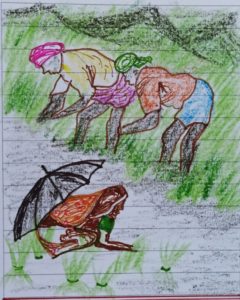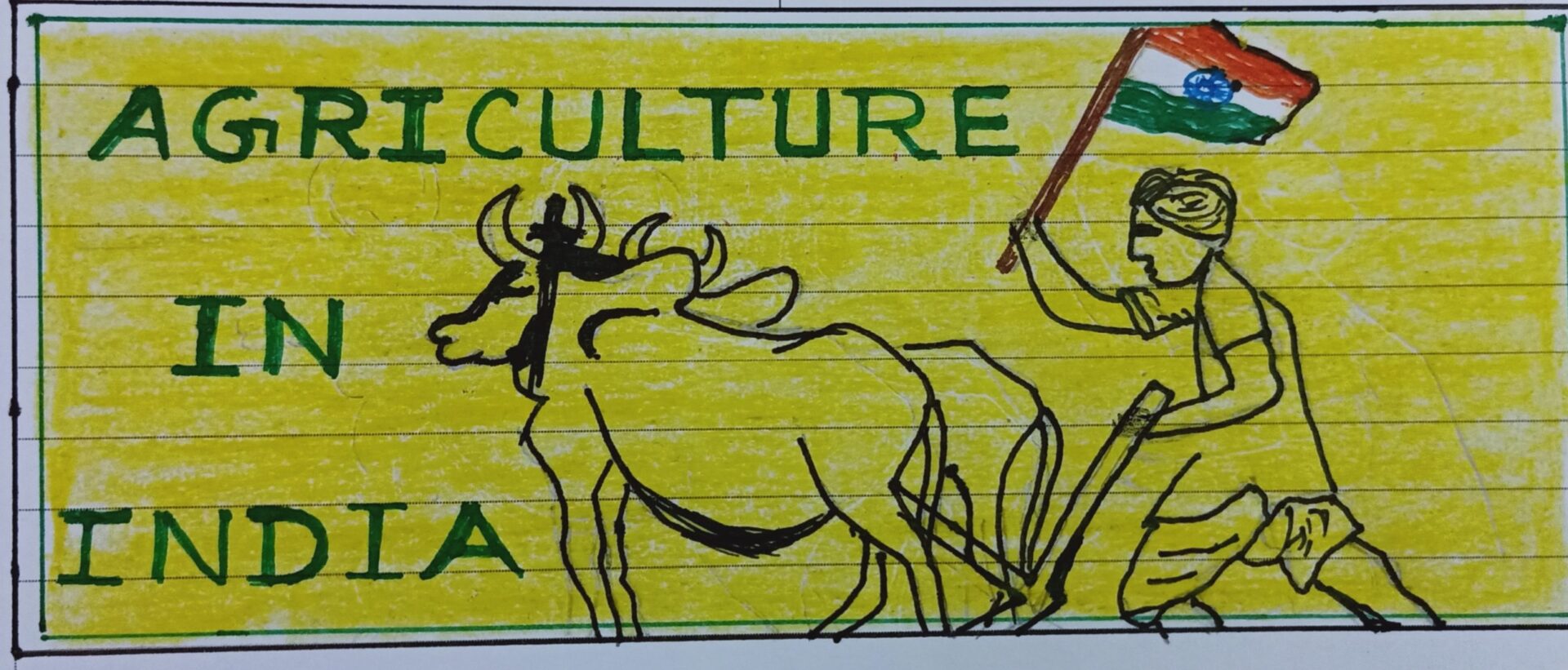Agriculture In India Chapter 4 Class X With Art Integration
Agriculture in India is important to support Indian economy.
More than half of the population is engaged in agriculture.
However, in the coming days agriculture in India, is going to be the most demanding sector.
It alone contributes (18%) a major part of our total GDP.
Moreover, Agriculture in India also support industries and fulfills our basic requirements.
AGRICULTURE:
Firstly, It is an important chapter for students who are going to write board exams this year.
Moreover, A good preparation requires better understanding of the chapter.
Both, long and short answer type questions can be asked from Agriculture chapter.
Lastly, those preparing for competitive exams also cannot neglect this chapter.
AGRICULTURE IN INDIA
i) In India, 60% people do farming.
ii) Agriculture is a basic activity thus produces most of the food and food grains.
iii) It produces raw materials and supports various industries like cotton, jute etc.
iv) India exports Agricultural products like tea, coffee, spices etc. which brings foreign exchange.
v) Lastly, It contributes to Gross Domestic Product (GDP) between 15-18 percent.
TYPES OF AGRICULTURE IN INDIA:
1 PRIMITIVE SUBSISTENCE FARMING:
I) Farming in done on a small piece of land.
ii) People use old tools therefore production is less.
iii) depends on monsoon and soil fertility .
iv) mainly food crops are grown for self consumption.
v) Farmers do not use fertilizers and other inputs.
vi)) Tribal people of Eastern states practice this type of farming.
It is also known by different names in different parts of the country.
TRIBAL WAY OF DOING AGRICULTURE IN INDIA

AGRICULTURE IN INDIA
SHIFTING CULTIVATION:
i_ a part of forest is burnt or cut for growing crops.
ii) crops are grown to sustain their family.
iii) after 2-3 years, when soil looses its fertility,
farmers shift and clear new patch of forest land.
iv) Soil regains its fertility naturally.
v) known as Milpa in Mexico and
Jhumming in North Eastern states of India.
2 INTENSIVE SUBSISTENCE FARMING IN INDIA:
I) mainly done in areas where the population is high.
ii) Good quality seeds are used for high production.
iii) production increases by adding chemicals.
iv) Production per hectare is very high.
v) More than one crop is grown in a year.
vi) farmers try to take maximum profit from limited land.
however, division of land is further making farming difficult.
3. COMMERCIAL FARMING IN INDIA:
i) modern machines are used.
ii) High quality seeds, fertilizers etc. are used to increase the production.
iii) production varies from place to place.
iv) Plantation is also a type of commercial farming.
v) In this, one single crop is grown on a large area.
vi) It is similar to factory production.
vii) it requires huge money and skilled labors.
viii) Tea, coffee and sugarcane are important plantation crops.
ix) Apart from that, it requires market and fast network of transport and communication.
Can you explain all the three types of farming ?
CAN YOU TELL THE REASON WHY FARMERS IN INDIA COMMIT SUICIDE ?
AGRICULTURAL SEASONS IN INDIA:
i) KHARIF:
a) Kharif season starts with the beginning of rainy season i.e. June-July
b) important crops grown are rice, maize, cotton, jute and groundnuts.
c) These crops require temperature above 25°C with high humidity.
d) Requires rainfall above 100 cm but, areas with less rainfall needs irrigation.
II) RABI:
a) farmers sow crops during the winter season.
b) planted between October to December and cut between April to June.
c) important crops grown are wheat, gram, mustard, Barley and peas.
d)These crops require cool temperature below 25°C.
e) Finally, Requires less rainfall between 50-75 cm
iii) ZAID:
a) Firstly, a short agricultural season during the summer months.
b) Secondly, farmers use river side soil to grow crops.
c) Thirdly, important crops grown are watermelon, muskmelon, cucumber, vegetables and flowers.
d) Finally, not a very important season but helps in extra income of the farmers.
STEPS TAKEN BY THE GOVERNMENT TO IMPROVE AGRICULTURE IN INDIA:
Important technological reforms in Indian agriculture:
a) Firstly, improved irrigation facilities
b) Secondly, introduction of HYV of seeds
c) availability of Fertilizers and Insecticides to increase agricultural production.
Important Institutional reforms in Indian agriculture:
a) consolidation of land holdings – bringing the scattered land at one place.
b) abolition of Zamindari system.
c) Crop insurance
d) special weather reports and agricultural programs on radio and T.V.
e) establishments of agricultural institutes and research centers.
f) announcement of Minimum Support Price
g) Lastly, schemes like Kissan Credit Card and Loan facilities at low interest rates.
Now, can you write five points each for technological and institutional reforms by the government ?
THE FARMERS OF BIHAR, U.P, ORISSA ARE POOR BUT FARMERS FROM MAHARASHTRA AND GUJARAT COMMIT SUICIDE, WHY ?
PROBLEMS FACED BY JUTE INDUSTRY JUST AFTER INDEPENDENCE:
I) after partition, major Jute producing area went to Bangladesh and Jute mills remained in India.
ii) Therefore, India had to import raw jute from Bangladesh to run Jute mills which increased the production cost.
iii) Moreover, India had to face stiff competition with Bangladesh and Brazil.
iv) Old and outdated mills further reduced the production.
v) Finally, plastic industry further reduced the demand of jute.
THREE IMPORTANT FEATURES OF COTTON:
i) Firstly, an important raw material for cotton textile industry.
ii) Secondly, grows well in Black soil.
Read about soils https://shapingminds.in/soils-of-india/ of India
iii) it requires 210 frost free days with bright sunshine for 6-8 months to get ready.
THREE IMPORTANT FEATURES OF OIL SEEDS
I) Firstly, India is the largest producer as well as consumer of oil seeds in the world.
ii) Secondly, oil seeds are edible and used for cooking.
iii) Thirdly, it is also used as raw material as well as in the production of soap and cosmetics.
important oil seeds are Groundnuts, Soybean, castor seeds, sunflower, coconut and Linseed.
DO YOU KNOW ABOUT BLOODLESS REVOLUTION:
i) Acharya Vinoba Bhave – spiritual Guru of Mahatma Gandhi.
ii) In support of Gram Swarajya and wanted to spread it all over India.
iii) In Andhra Pradesh, some poor farmers requested for land for farming. https://thediplomat.com/2017/02/indias-bitter-seeds-the-plight-of-small-farmers/
iv) suddenly, a rich villager, inspired by Vinoba Bhave, donated eighty acres of land.
v) This act is “Bhoodaan”.
vi) he continued his idea of Gram Swarajya all over India and gained popularity.
vii) rich farmers offered some villages to the poor.
viii) This was “Gramdaan”
ix) rich farmers also had the fear of Land ceiling Act,
x) This was Bloodless Revolution..
WHAT TO PREPARE FOR BOARD EXAM FROM AGRICULTURE CHAPTER:
Q1. A crop which is commercial in one region and provide subsistence in another. ( 1 mark )
Q2. Why do farming practices vary in different regions of India. Give three reasons. (3 marks )
Q3. Why agriculture is called the ” Backbone of Indian economy“? Give three reasons. ( 3 marks )
Q4. Difference between Subsistence farming and Intensive farming. ( 3 marks )
Q5. Mention five characteristics of Plantation agriculture ? ( 5 marks )
Q6. “Reforms in agriculture are necessary.” Enlist various Institutional and Technological reforms taken by Indian Government to bring about improvements in agriculture. ( 5 marks )
CONCLUSION:
Firstly, Agriculture in India is the largest occupation hence provides both- food security and rural employment.
Indian agriculture has seen Green, Blue, white and yellow revolution.
Moreover, By improving soil quality, irrigation facility, technology, and research work, agriculture in India can improve.




0 Comments